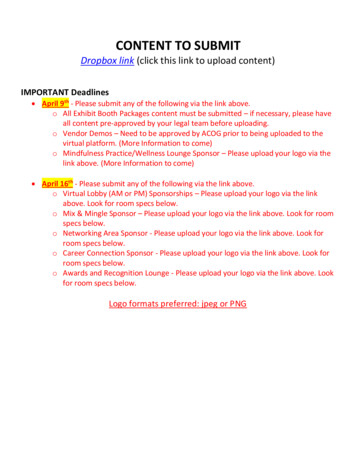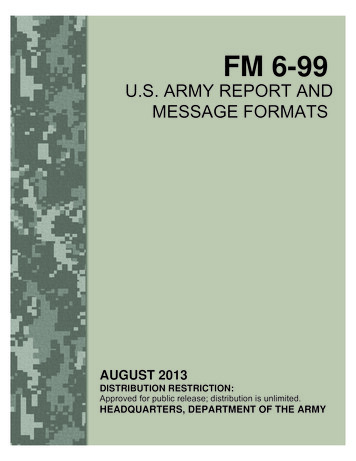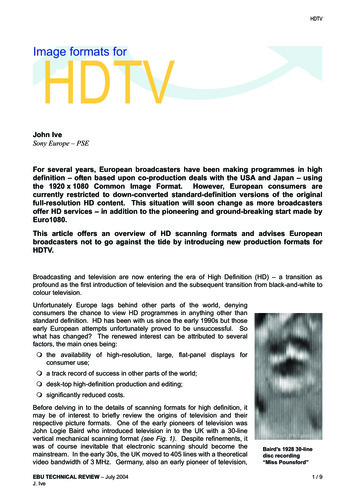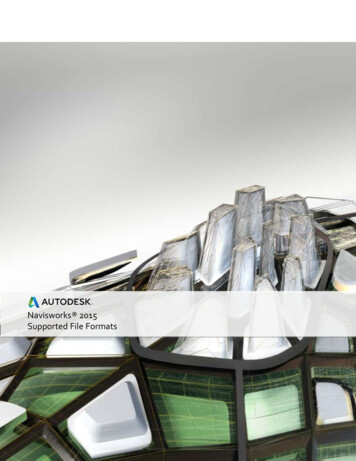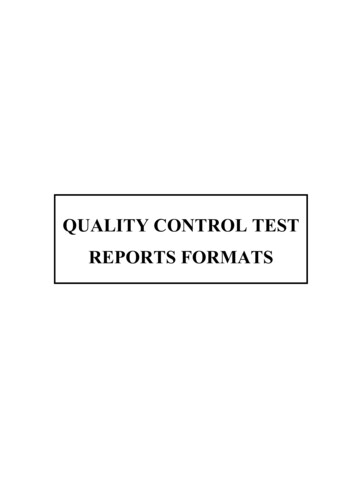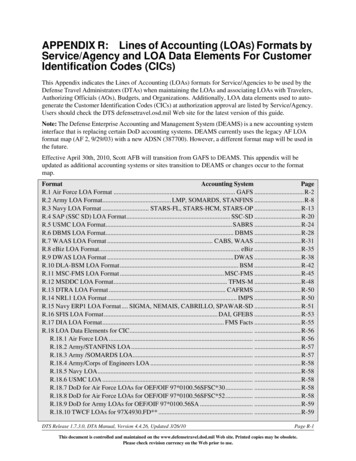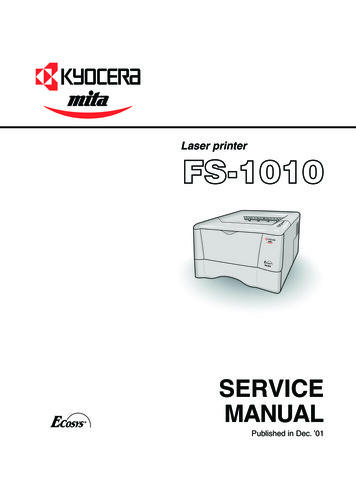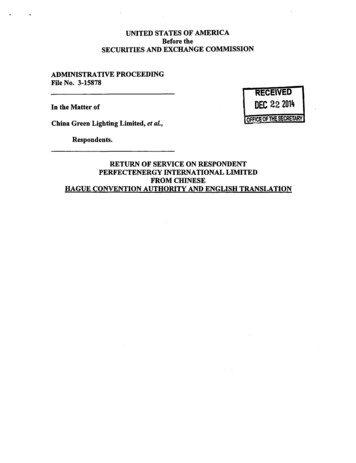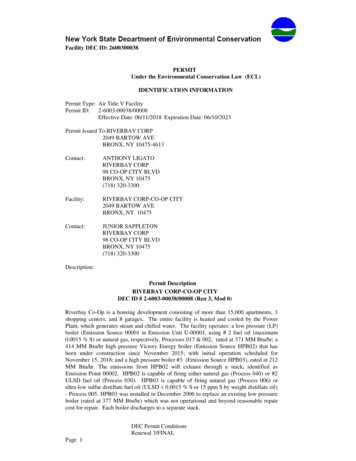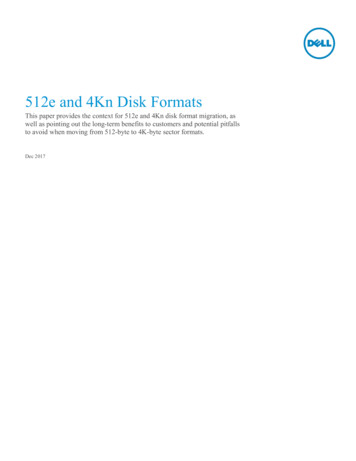
Transcription
512e and 4Kn Disk FormatsThis paper provides the context for 512e and 4Kn disk format migration, aswell as pointing out the long-term benefits to customers and potential pitfallsto avoid when moving from 512-byte to 4K-byte sector formats.Dec 2017
A Dell Technical White PaperTHIS WHITE PAPER IS FOR INFORMATIONAL PURPOSES ONLY, AND MAY CONTAIN TYPOGRAPHICAL ERRORSAND TECHNICAL INACCURACIES. THE CONTENT IS PROVIDED AS IS, WITHOUT EXPRESS OR IMPLIEDWARRANTIES OF ANY KIND. 2016 Dell Inc. All rights reserved. Reproduction of this material in any manner whatsoever without the express written permissionof Dell Inc. is strictly forbidden. For more information, contact Dell.Dell, the DELL logo, and the DELL badge are trademarks of Dell Inc. Other trademarks and trade names may be used in thisdocument to refer to either the entities claiming the marks and names or their products. Dell disclaims any proprietary interest in themarks and names of others.Dell - Internal Use - Confidential2512e and 4Kn Disk Formats
Contents1Overview . 32Background . 43The long-term benefit of 4K sectors . 54Understanding the impacts of the 4K transition. 5514.1512-byte sector emulation . 64.2Small or runt writes . 74.3Mixing drives . 7Preparing for and managing the 4K transition . 75.1Managing 4K sectors in the Windows environment . 85.2Enterprise Windows support for 4K sector media . 85.3Managing 4K sectors in the Linux environment . 95.4VMware support . 95.5Dealing with unaligned conditions . 95.6512e/4Kn application support . 106Drive labels . 107Conclusion . 118Additional resources . 11OverviewA change is coming in the hard drive industry. As storage densities dramatically increase, one of the most elementalaspects of hard drive design — the logical block format size known as a sector — has remained constant. The storageindustry is quickly ramping up efforts to transition to a new type of format for media, known as Advanced Format,which has a 4KB physical sector size. This change brings two new types of media to the enterprise market: 4KB native: This media has no emulation layer and directly exposes 4KB as its logical and physical sector size.The overall issue with this new type of media is that the majority of current and legacy applications andoperating systems do not query for and align I/Os to the physical sector size, which can result in unexpectedfailed I/Os. 512-byte emulation (512e): This media has an emulation function and exposes 512 bytes as its logical sector size(similar to a regular disk today), but makes its physical sector size information (4KB) available. The overallissue with this new type of media is that the majority of applications and operating systems do not understand theexistence of the physical sector size, which can result in a number of issues.Dell - Internal Use - Confidential3512e and 4Kn Disk Formats
Table 1Format typesFormat typeBytes per sector valueBytes per physical sector value512n512512512e5124,0964Kn4,0964,096Beginning in late 2009, accelerating in 2010, and hitting mainstream in 2011 for client-based HDDs, hard drivecompanies began migrating away from the legacy sector size of 512 bytes to a larger, more efficient sector size of 4,096bytes, generally referred to as 4K sectors, and now referred to as Advanced Format by IDEMA (The International DiskDrive Equipment and Materials Association). Enterprise HDDs are also moving to this format, but are slower inadoption. The first Advanced Format enterprise HDD became available in 2012, with a limited set in 2013 and a moregeneral distribution in 2014. By 2017, Dell Enterprise PowerEdge has seen very low adoption rate of 4Kn (less than 2%share of total HDDs) and shifting offering strategy to limit 4Kn SAS HDDs on 14 th generation PowerEdge.This paper provides the context for this migration, as well as the long-term benefits and potential pitfalls to avoid whenmoving from 512-byte to 4K-byte sectors.2BackgroundThe legacy sector format contains a Gap section, a Sync section, an Address Mark section, a Data section and ErrorCorrection Code (ECC) section as shown in Figure 1.Figure 1Legacy sector formatThe sector layout is structured as follows: Gap section: The gap separates sectors.Sync section: The sync mark indicates the beginning of the sector and provides timing alignment.Address Mark section: The address mark contains data to identify the sector’s number and location. It alsoprovides status about the sector itself. Data section: The data section contains all of the user’s data.ECC section: The ECC section contains error correction codes that are used to repair and recover data that mightbe damaged during the reading or writing process.This low-level format has served the industry well for many years. However, as hard drive capacities have increased,sector size has increasingly become a limiting design element in improving hard drive capacities and error correctionefficiency. For example, comparing the ratio of sector size to the total capacity of earlier hard drives to more recentDell - Internal Use - Confidential4512e and 4Kn Disk Formats
drives, the sector resolution has become extremely small. The resolution of the sector (the ratio of sectors as a percentageof total storage) has become very fine and increasingly inefficient as shown in Table 2.Table 2Sector resolutionCapacityTotal sectorsSector Very fine resolution is good when managing small, discrete amounts of data. However, applications common in moderncomputing systems manage data in large blocks, much larger in fact than the legacy 512-byte sector size. Moreimportantly, the small 512-byte sector has consumed a smaller and smaller amount of space on the hard drive surface asareal densities have increased.The migration to larger sectors within the hard drive industry has become a fundamental need relative to gainingimprovements in error correction and achieving format efficiencies.3The long-term benefit of 4K sectorsSince all hard drive manufacturers have agreed to transition to the Advanced Format sector, the industry must adapt toand embrace this change to minimize potential negative side effects. Short-term benefits to end users will not bedramatic in terms of immediate capacity increases. However, the migration to 4Ksized sectors will most definitelyprovide quicker paths to higher areal densities and hard drive capacities, as well as more robust error correction.Reducing the amount of space used for error correction code improves format efficiency.The legacy 512-byte sector has non-data-related overhead for the Gap, Sync and Address Mark sections for every 512byte. The new Advanced Format standard of a 4K-byte sector essentially combines eight legacy 512-byte sectors into asingle 4K-byte sector. The Advanced Format standard uses the same number of bytes for Gap, Sync and Address Mark,but increases the ECC fields. This yields a format efficiency of 97 percent, almost a 10 percent improvement. Together,the benefits of improved format efficiency and more robust error correction make the transition to 4K sectors well worththe effort. Properly managing this transition to capture the long-term benefits with minimal side effects is a key focus forthe hard drive industry.4Understanding the impacts of the 4K transitionAs noted earlier, there are many aspects of modern computing systems that continue to assume that sectors are always512 bytes. To transition the entire industry over to the new 4K standard and expect all of these legacy assumptions tosuddenly change is simply not realistic. Over time, the implementation of native 4K sectors, where both host and harddrive exchange data in 4K blocks, will likely take place. Until then, Dell and our competition will also implement the 4Ksector transition in conjunction with a technique called 512-byte sector emulation.The most critical aspect of a smooth and successful transition to 4K sectors used in Advanced Format is performance.Whether you are a system builder, OEM, integrator, IT professional or end user building or configuring a computer, toensure you have the performance you need for a successful transition, use the operating system to align partitions on a4Kn drive boundary.For operating system versions that are not 4K-sector aware, use third-party software or utilities to create hard drivepartitions. To ensure the software or utilities you are using are 4K-sector aware, check with your Dell team.Dell - Internal Use - Confidential5512e and 4Kn Disk Formats
4.1512-byte sector emulationThe introduction of 4K-sized sectors depends heavily on 512-byte sector emulation. This term refers to the process oftranslating from the 4K physical sectors used in Advanced Format to the legacy 512-byte sectors expected by hostcomputing systems.The 512-byte emulation is acceptable in that it does not force complex changes in legacy computing systems. However,it carries the potential for negative performance consequences, particularly when writing data that does not neatlycorrespond to eight translated legacy sectors, as evident by the 512-byte emulation writing process.4.1.1Emulated read and write processesTo read data from a 4K sector formatted drive in 512 emulation mode, the process is very straightforward, as shown inFigure 7.Figure 2Potential read sequence for 512-byte emulationThe process of reading the 4K block of data and reformatting to the specific 512-byte emulated sector requested by thehost computer is performed in the drive’s DRAM memory and does not measurably impact performance.A write process will be more complicated, particularly when data the host computer attempts to write is a subset of aphysical 4K sector. In these cases, the hard drive must first read the entire 4K sector containing the targeted location ofthe host write request, merge the existing data with the new data, and then rewrite the entire 4K sector as shown inFigure 3. The fundamental reason for this is that the drive cannot write just a portion of the 4K sector, but can only writethe entire sector at once.Figure 3Potential write sequence for 512-byte emulationIn this instance, the hard drive must perform extra mechanical steps in the form of reading a 4K sector, modifying thecontents and then writing the data. This process is called a read-modify-write (RMW) cycle, which is undesirablebecause it has a negative impact on hard drive performance. Minimizing the probability and frequency of read-modifywrite instances is the most important aspect of making the transition to 4K sectors smooth and painless.The causes of read-modify-write reduced performance include:Dell - Internal Use - Confidential6512e and 4Kn Disk Formats
4.1.2Write requests that are misaligned because of logical to physical partition misalignmentWrite requests smaller than 4K in sizeWrite requests that are not multiple of 4K in sizeAligned versus unaligned hard drive partitionsUp to now we have not discussed how host systems and hard drives communicate the location of sectors on the media.It’s time to introduce the Logical Block Address (LBA).Each 512-byte sector is assigned a unique LBA, from zero (0) to the number required based on the size of the disk. Thehost requests a specific block of data using the assigned LBA. When the host requests to write data, an LBA address isreturned at the end of the write request telling the host where the data is located. This becomes important in the transitionto 4K sectors since for every 4K sector there are eight different possibilities for where the host LBA starts.When LBA 0 is aligned to the first virtual 512-byte block in the 4K physical sector, the logical to physical alignmentcondition for 512-byte emulation is termed Alignment 0. Another possible alignment is when LBA 0 is aligned to thesecond virtual 512-byte block in the 4K physical sector. This situation is termed Alignment 1. There are six additionalpossibilities for unaligned partitions that can result in read-modify-write events similar to the Alignment 1 condition.Alignment 0 conditions work very well with the new 4K sectors in the Advanced Format standard. This is because a harddrive can easily map eight contiguous 512-byte sectors into a single 4K sector by storing 512-byte write requests in thehard drive’s cache until enough contiguous 512-byte blocks are received to form a 4K sector. Since modern computingapplications deal with chunks of data that are typically larger than 4K, runts (transfers smaller than 4K) are extremelyrare. However, the Alignment 1 situation is another matter.When hard drive partitions are created that result in an unaligned condition, read-modify-write cycles occur that can slowhard drive performance. See section 5.5 for information on avoiding these cycles when implementing Advanced Formathard drives.4.2Small or runt writesIn modern computing applications, data such as documents, images and video streams are much larger than 512 bytes.Therefore, hard drives can store these write requests in cache until there are enough sequential 512-byte blocks to build a4K sector. As long as hard drive partitions are aligned, the hard drive can easily map 512-byte sectors into 4K sectorswithout any performance penalties. There are, however, certain low-level processes that can force a hard drive to handlerunt writes that are not associated with unaligned partitions. When I/O size is either smaller than 4K or not a multiple of4K-sector size, the drive must handle the RMW and small writes in the same way. Dell recommends modifying theseprocesses to maximize performance for the 4K transition.4.3Mixing drivesIf you decide to use a mix of drive types, but do not resolve these issues, the overall storage performance may be lowerthan expected. To mix drives, you must have a good understanding of the operating system, applications, and theconfiguration such as RAID, volumes, and so on. 4Kn drives cannot be mixed with 512e within an array. To ensurecompatible drive mix, check with your Dell team.5Preparing for and managing the 4K transitionNow that you understand the benefits of migrating to 4K sectors, as well as the potential impacts to performance, let'slook at ways to manage this transition through the context of applications and operating systems.Dell - Internal Use - Confidential7512e and 4Kn Disk Formats
5.1Managing 4K sectors in the Windows environmentThe single most important aspect of managing the transition to 4K sectors is related to the 512-byte emulation drivealignment issues described in section 4. Advanced Format drives work well in anAlignment 0 condition, where the physical to logical starting position are equal. Alignment conditions are created whenthe hard drive partition(s) is created.5.2Enterprise Windows support for 4K sector mediaTable 3 lists the Microsoft Windows support policy for various media and their resulting reported sector sizes. Logical sector: The unit that is used for logical blocks addressing for the media. We can also think of it as thesmallest unit of write that the storage can accept. Physical sector: The unit for which read and write operations to the device are completed in a single operation.This is the unit of atomic write.Table 3Windows supportDrive formatsReported logicalsector sizeReported physicalsector sizeWindows version with support512-byte Native, 512n512 bytes512 bytesAll Windows versionsAdvanced Format, 512e, AF, 512 bytes512-byte Emulation4096 bytesWindows Server 2016Windows Server 2012Windows Server 2008 R2 with MSKB 982018Windows Server 2008 R2 SP1Windows Server 2008 with MS KB2553708Advanced Format, AF, 4KNative, 4Kn*4096 bytesWindows Server 2016Windows Server 2012(4k data disks are supported and as bootdisks in UEFI mode)4096 bytesNote that Windows Server 2003 and Windows Server 2003 R2 do not support 512e or 4Kn media. While the system mayboot up and operate minimally, there may be functionality issues, data loss, or suboptimal performance. Dell does notrecommend using 512e media with Windows Server 2003.There are a number of software utilities (such as Diskpart and Paragon) that are widely used by system builders, OEMs,value-added resellers, and IT managers for aligning partitions when the operating system doesn't offer or supportpartition alignment out of the box. Systems today typically consist of multiple hard drive partitions. This means that eachpartition on the hard drive must be created with 4K-aware partitioning software to make sure proper alignment andperformance is ensured.Dell - Internal Use - Confidential8512e and 4Kn Disk Formats
5.3Managing 4K sectors in the Linux environmentThe key strategies in managing the transition to 4K sectors in a Windows environment also apply to Linux.Table 4Linux supportDrive formatsReported logicalsector sizeReported physicalsector sizeLinux version with support512-byte Native, 512n512 bytes512 bytesAll Linux versionsAdvanced Format, 512e,AF, 512-byte Emulation512 bytes4096 bytesRHEL 6.1*SLES 11 SP2**Ubuntu 13.10Ubuntu 12.04.4Advanced Format, AF, 4KNative, 4Kn4096 bytes4096 bytesRHEL 6.1*SLES 11 SP2**Ubuntu 13.10Ubuntu 12.04.4*Red Hat Enterprise Linux 6 supports 4K-sector devices as data disks. 4K-sector boot disks are supported in UEFI mode only.**SUSE Linux Enterprise fully supports 4KB/sector drives in all conditions and architectures with one exception. The 4KB/sectorhard disk drives are not supported as a boot drive on x86 64 systems booting wit
'hoo ,qwhuqdo 8vh &rqilghqwldo h dqg .q 'lvn )rupdwv e\wh vhfwru hpxodwlrq 7kh lqwurgxfwlrq ri . vl]hg vhfwruv ghshqgv khdylo\ rq

